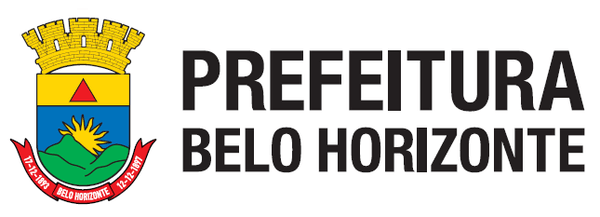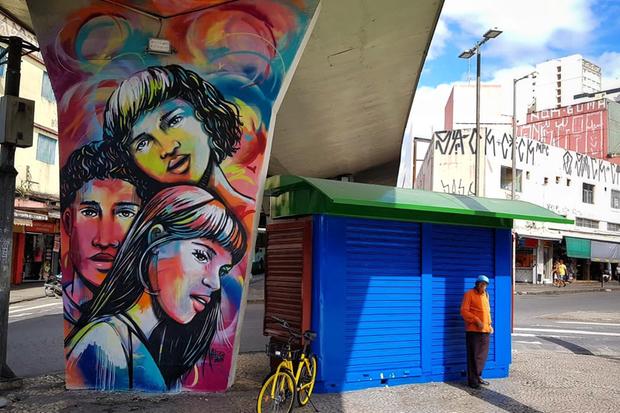 Graffiti by Italian artist Alice Pasquini colors a runway column in the Lagoinha neighborhood
Graffiti by Italian artist Alice Pasquini colors a runway column in the Lagoinha neighborhood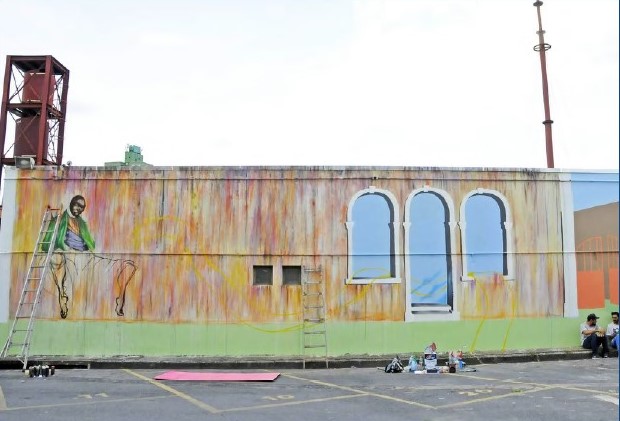 Local artist paint murals and grafitti. - © Belo Horizonte City Hall
Local artist paint murals and grafitti. - © Belo Horizonte City Hall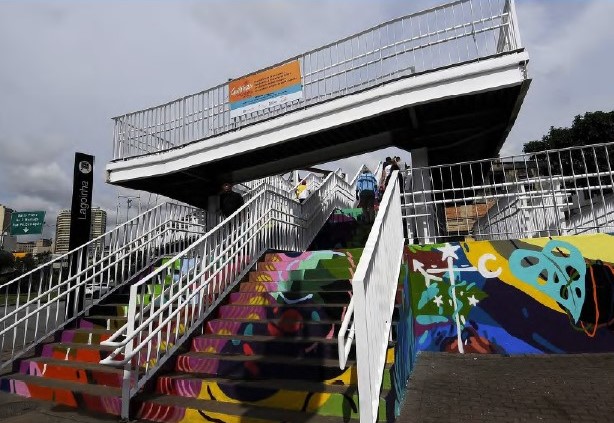 Artists Clara Valente, Gabriel Dias and João Gabriel - Renovation of urban infrastructure through art. - © Belo Horizonte City Hall
Artists Clara Valente, Gabriel Dias and João Gabriel - Renovation of urban infrastructure through art. - © Belo Horizonte City Hall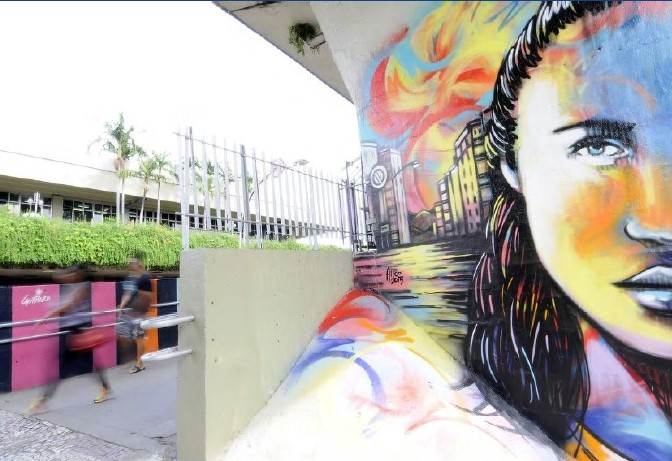 Grafitti by Italian Artist Alice Pasquini, invited by the City Hall and the Italian Consulate in Belo Horizonte - © Belo Horizonte City Hall
Grafitti by Italian Artist Alice Pasquini, invited by the City Hall and the Italian Consulate in Belo Horizonte - © Belo Horizonte City Hall Professional School Raimunda da Silva Soares 831 spots for Professional Qualification Courses - © Belo Horizonte City Hall
Professional School Raimunda da Silva Soares 831 spots for Professional Qualification Courses - © Belo Horizonte City Hall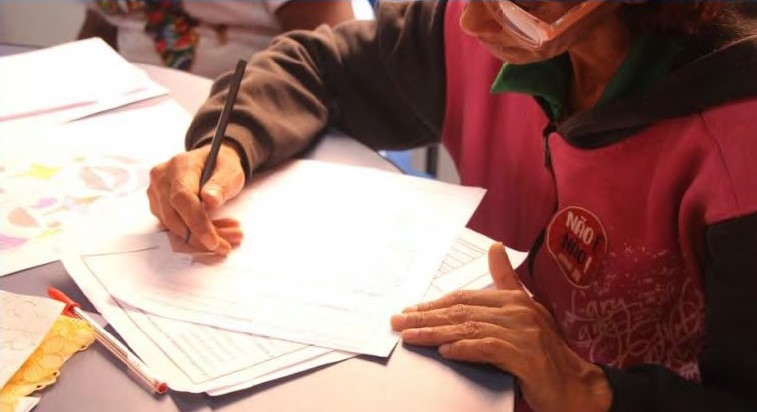 Professional School Raimunda da Silva Soares 831 spots for Professional Qualification Courses - © Belo Horizonte City Hall
Professional School Raimunda da Silva Soares 831 spots for Professional Qualification Courses - © Belo Horizonte City Hall
City
Belo Horizonte
Main actors
City Government, Private Sector, Community / Citizen Group
Project area
Whole City/Administrative Region
Duration
Ongoing since 2018
A strategic intersectoral project focussed on building a creative economy.
The Centro-Lagoinha neighbourhood, in the city of Belo Horizonte, currently faces challenges associated with marginalization, chemical abuse, homelessness, public safety, urban mismatch and isolation. To address this, the city administration is implementing a creative economy model to revitalize the area. The project’s main goal is to identify opportunities to develop and implement activities with cultural, creative and intellectual capital that will attract new investment and businesses to the neighbourhood and simultaneously promote socio-productive inclusion. This will combat poverty and promote effective economic inclusion through the generation of employment for local residents and foster social inclusion by providing access to health education, housing, transport, food, leisure and wellbeing services and activities.
The model creates opportunities for large, medium and small businesses and as there is significant female participation in the creative sectors it will contribute to the fulfillment of several of the SDGs.
Belo Horizonte is the first planned capital in Brazil. The city hosts the Pampulha Architectural Complex, a Cultural Heritage of Humanity, a fashion hub, a gastronomic hub (it is a UNESCO Creative City in the gastronomy sector), an innovative ecosystem and has one of the largest startup communities in Brazil. Belo Horizonte has great cultural and artistic diversity and the largest cultural access index among the country's capital cities. Approximately 21.5% of companies belong to the creative economy sector, which makes the city the third largest creative hub in Brazil. In 2017, creative activities generated around R$250million in monthly revenue and 104,000 jobs. Therefore, the project aims at providing the right environment for creative activities to thrive in the city.
The Centro-Lagoinha neighbourhood was chosen as the first territory to receive the project’s interventions, due to its historical and cultural significance. Once a vibrant precinct of bars, bohemia and music, with important architectural buildings, the neighbourhood currently has material barriers along with social stigma that segregates it from the rest of the city. It lacks infrastructure investment and has undervalued cultural potential.
In order to address territorial issues, the project comprises urban interventions for the revitalization of public spaces, improvement of the business environment, public safety, tourism and cultural promotion and it aims to revitalize and stimulate the creative sectors.
The implementation of the project is divided into 5 areas of action:
Public security
Expansion of security in the neighbourhood through the installation of surveillance cameras, the establishment of a Preventive Security Unit, and an investigation into the illegal trade in copper and scrap iron.
Social productive inclusion:
Actions to promote an entrepreneurial culture, professional qualifications and socioeconomic inclusion, through courses and workshops, especially addressed to the people in vulnerable situations who have entrepreneurial potential.
Improving the business environment:
Technical partnerships for strengthening and improving project management and training courses for managers and entrepreneurs. Drafting of the Creative Economy map. Attract investors, business and credit lines for entrepreneurs. Encourage the economic reoccupation of properties in the neighbourhood.
Cultural and tourist dynamism:
Drafting of the cultural cartography of the neighbourhood, acceleration of the historic houses listing processes for reform and revitalization, promotion of the cultural economy sectors, promotion of cultural events, historical survey and contextualization of the importance of the area. Mapping of services, local attractions and cultural offers, survey and expansion of tourist tours.
Requalifications and urban interventions:
Make street art viable, improve infrastructure, lighting and maintenance in the neighbourhood, seek partnerships for the adaptation/reform of the public squares (Adote o Verde Program), construction of the Lookout on Rua Diamantina.
The project involved several branches of City Hall, such as culture, tourism, urban policy, social assistance, technology and information, social communication and security. In addition, partnerships were signed with the Italian Consulate, the Support Service for Small and Micro Enterprises of Minas Gerais, Development Bank of Minas Gerais, in addition to the involvement of civil society organizations such as the Viva Lagoinha movement. (Viva Lagoinha is an informal civil society movement that aims to connect people participating in the creative economy, with a focus on valuing the region and preserving its memory.)
PROJECT: CREATIVE HORIZON Timeline
6/30/19 - Elaboration of the Creative Economy map.
08/09/19 - Diagnosis of gastronomic offer and tourist potential in the area
12/30/19 - Offer of 50 places for training courses (basic informatics, social media, programming, assembly, maintenance and recycling of computers) at Escola Profissionalizante Raimunda da Silva Soares
12/30/19 - Provision of vacancies in vocational courses for the vulnerable population. Confectionery: 40 vacancies; Gastronomy: 50 vacancies; Bakery: 60 vacancies
12/30/20 - Listing of the set of buildings located on Rua Itapecerica
8/30/19 - Completion of the neighborhood's cultural cartography
6/15/19 - Training of teachers from 9 EJA schools in the Lagoinha region - Entrepreneurial Education Program
12/30/19 - Intensify enforcement in order to reduce the illegal trade in copper and scrap iron in the Lagoinha neighbourhood
11/29/19 - Conclusion of a study for the implementation of a video monitoring system, including an image transmission network, server, storage, VMS licenses, cameras, physical installation infrastructure (pole, electrical network, foundations, etc.).
09/30/20 - Deployment of Preventive Security (Mobile) Unit
4/20/19 - Maintenance of the bus station walkway to receive the graffiti (cleaning, washing and base painting).
4/20/19 - Maintenance and improvements in the Lagoinha Market (cleaning, painting and gardening) which will be a strategic point of the project
9/30/19 - Improvement of public lighting in the Lagoinha neighbourhood - replacement by Led lamps
4/30/19 - Gentileza Lagoinha Project - Execution of the graffiti on the busway walkway, the IAPI wall, the Cultural Center wall and the viaduct shallow)
12/30/20 - Formalize partnerships for urban interventions and adoption of squares / green areas in Lagoinha with at least two partnerships signed
12/30/20 - Prospecting companies and businesses for the Lagoinha neighbourhood with at least three signed memoranda of understanding
The project is led by the Municipal Economic Development Secretariat, who act as the coordinator with the other areas of City Hall, the private sector and the local community. The Development Secretariat did not invest direct resources in the project, however, other municipal bodies used existing resources to direct efforts to the project.
The entire team of the Municipal Secretariat for Development (Directorates for Strategic Projects and Innovation, Investment Attraction and International Relations) are involved in the project, with the Municipal Secretary being the leader.
In addition, the project team received, free of charge, SAP Social Sabbatical consultancy, three international consultants, two from Germany and one from Canada, who stayed in Belo Horizonte from May 20 to 31. Participation in the SAP and Pyxera Global program contributed to a better structuring of the project, by bringing experience and know-how, in addition to improving the technical capacity of the team of the Municipal Secretariat for Economic Development in structuring and developing the project.
The following actions have taken place:
- Safety Operations in Public Transport with the installation of 213 new LED streetlamps
- Opening of the Women Civic-Service Center with 80 spots for Entrepreneurship and Qualification Courses
- 831 spots for Professional Qualification Courses in a local school
- A round of Investment Promotion, International Consultation by SAP/Pyxera Global,
- Painting of walls by Movimento Gentileza at Mercado Lagoinha,
- Exhibit a documentary of the local residents ("Moradores da Lagoinha"),
- Construction of Lagoinha Overlook,
- Realization of Cura Lagoinha Cultural and Historic Festival
The following actions will take place:
- Strategic planning workshops for local leaders
- installation of a UAITECH unit (technical school) in a local School
- Cultural mapping of the region
- Conclusion of the heritage protection and renovation of the historic houses
- Fostering of partnerships and for the renovations of Lagoinha's public squares
- Studies to revitalise and reoccupy the adjacent and underpass areas of viadu
- Attracting new businesses and investment to the region.
These actions directly public safety, socio productive inclusion, business environment improvement, tourism and culture activities and urban infrastructure revitalisation
The Lagoinha neighbourhood is an area of the city that has a contradictory image. For those who live in it and know its history, it is seen as a vibrant creative, cultural and historical hub. For others, it often represents a derelict area of the city.
The possible resistance of the project's target audience (residents, potential entrepreneurs, traders, homeless people, etc.) represented a challenge. It was surmised that this resistance could occur due to the large number of public interventions that the territory had undergone in the past and mostly without the participation of the community, the high number of people living on the streets, illegal trade, the fear of investing in the area by entrepreneurs and the fear of real estate speculation by residents. Fortunately, through extensive communication channels, there has been no resistance to the project.
Lessons learned:
The biggest success factor of the project was the ability to mobilize community power to join forces around a common goal.
As an intersectoral action with the local community and in partnership with the private sector, the results were significant, and with low investment of government resources that are already scarce. There has already been a great transformation in the territory in urban terms, and in terms of belonging to the city and in demystifying the negative image of the area. There has also been an increased sense of security.
City Hall must continue to invest in the socio-productive inclusion of the local community so that the neighbourhood can further develop and subsequently generate more jobs. As it is an important region historically, tourist and cultural attractions are good possibilities for new businesses in the developed region.
Transferability:
The creative economy is not only a relevant sector of the economy and a significant contributor to the national Gross Domestic Product, it also drives inclusive development for medium and small businesses, given that the traditional trade in creative goods and services makes up an important part of the local economies of many countries.
Considering UNCTAD data, the global market for creative goods has more than doubled in recent decades, from 208 billion in 2002 to 509 billion in 2015, with an average annual growth rate of 7.34% during the period from 2003 to 2015. The creative economy has been successful even during periods of crisis, more space and relevance in international trade, mainly among the developing countries.
In view of the transformative potential inherent to this economic activity, international cooperation projects for the expansion of the creative economy allow the strategic development and improvement of initiatives through the exchange of experiences. Thus, the project could be transferable to any city that acknowledges the value of the creative economy and has a creative ecosystem.
Theoretical Framework:
According to data from the Federation of Industries of the State of Rio de Janeiro (FIRJAN), industry in the country has shown significant development in the last decade. It is estimated that the sector generates around R$ 126 billion, equivalent to 2.6% of the total produced by Brazil in 2013. In ten years, this market may grow 69.8% in real terms, surpassing the 36.4% increase in national GDP in the same period. Compared to neighbouring countries, Brazil demonstrates space for creative activities to grow even more. In Ecuador, for example, the contribution of GDP from the creative economy is 5%; in Argentina, 3.5%; and in Colombia, 3.4%, according to the Creative Economy Report 2013, produced by the United Nations Educational, Scientific and Cultural Organization (Unesco) and the United Nations Development Program (UNDP).
In the 2015-2017 period, Brazil had 1.7 million of its jobs closed, therefore, creative professions were incorporated. All of them, in one way or another, relate to the global context of digital transformation and enhancement of the consumer experience. Together, they are responsible for generating 25,500 jobs.
In terms of remuneration, the best paid professionals are located in the Federal District (R $ 9,212.00, with high salaries in three of the four segments: Architecture, Design and Advertising & Marketing), in Rio de Janeiro (R $ 7,490.00 , with all segments registering high salaries) and in São Paulo (R $ 6,707.00, with relatively high remuneration and the highest average remuneration in the country in Advertising & Marketing).
São Paulo and Rio de Janeiro continue as the most representative states in the market: together, they concentrate 50% of all creative professionals in the country (328,700 creative jobs in São Paulo and 88,900 in Rio de Janeiro). Two other highlights are Santa Catarina and Rio Grande do Sul: they make up the list of states with the participation of creatives above the national average (1.8%). In Santa Catarina, 2.1% of all workers are creative, while in Rio Grande do Sul the proportion is 1.9%.
Strategies:
Culture, creativity and knowledge are the raw materials of the creative economy and the only resources that are not exhaustive. The more it is used, the more it multiplies and renews itself. The best way to apply the concept of the creative economy as a development strategy is through knowledge management, that is, making individual knowledge accessible to third parties.
In this way, it is possible to dissipate knowledge in the company and promote the decentralization of processes by training other professionals, in addition to being a strategy for the sustainability of the planet, of the human species and also of companies.
Bibliographical References:
http://www.engema.org.br/XVIENGEMA/435.pdf
https://online.unisc.br/acadnet/anais/index.php/sidr/article/viewFile/16648/4277
https://www.fecomercio.com.br/noticia/economia-criativa-desponta-e-aquece-o-mercado-de-trabalho
On Map
The Map will be displayed after accepting cookie policy
